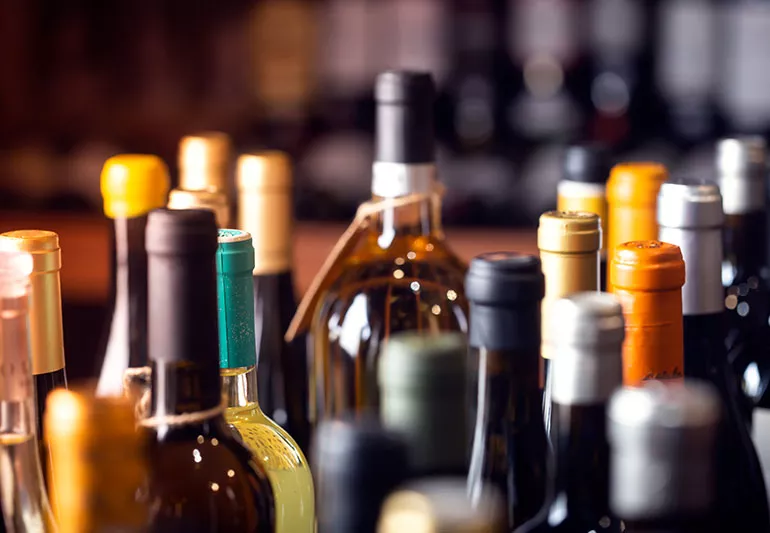I teach a course called “Chemical Dependency Issues,” and I am always surprised by how little my students have been taught about the effects of alcohol. They have been told to “drink responsibly” their whole lives, but few know how to actually do that—beyond not drinking and driving.
- 1. Know how much alcohol you’re using.
- 2. “Low-risk” alcohol use is different for men and women.
- 3. Blood alcohol levels continue to rise for 90 minutes after the last drink, and nothing helps you sober up but time.
- 4. Don’t mix alcohol with other psychoactive substances or prescription drugs.
- 5. Be cautious using alcohol alone.
- 6. Be cautious using alcohol with strangers or in high-risk situations.
- 7. Avoid driving or other dangerous activities if you’re using alcohol.
- 8. Don’t use alcohol if it causes problems in your life.
- 9. Be cautious using alcohol if you have risk factors for addiction.
- 10. Know the signs of alcohol addiction and seek help early.
The majority of “drink responsibly” messages focus on extreme harms rather than the more common alcohol-related problems. And there are strong arguments that the “Drink Responsibly” tagline itself is problematic because it has been used to perpetuate unscientific distinctions between alcohol and other psychoactive substances.
Framing alcohol as a substance that is harmless if you use it “responsibly” has enabled a culture that views alcohol as less problematic, and more essential, than other drugs.
It also has placed the blame for alcohol addiction on the user, not the product. With opioids, cocaine, and other drugs, the message is quite different—addiction to those substances is blamed at least partially on the substance and the providers/dealers, and any use is considered problematic.
But research shows that 5.6 percent of Americans ages 18+ meet criteria for alcohol use disorders (roughly 14 million), while only 0.6 percent meet criteria for opioid use disorder (roughly 1.5 million) and 1.5 percent meet criteria for any drug use disorder other than cannabis or alcohol (roughly 3.8 million).
Yet we still see this artificial distinction: “drink responsibly,” but don’t use other drugs at all. And if you do use other drugs, “ harm reduction/minimization” is the goal, which ignores the potentially beneficial effects of other substances and keeps a negative frame on non-alcohol substances.
Alcohol is America’s sweetheart substance, often viewed as an essential component of a happy life despite research showing that 30 percent of Americans ages 18+ drink less than one drink per year.
I would argue for more equal treatment of alcohol and other drugs—it should be “harm minimization” for alcohol as well, or “use responsibly” for all psychoactive substances. “Drink responsibly” is essentially a harm minimization slogan; it just isn’t specific about how to avoid alcohol-related problems.
Since “Use [substance] responsibly” has more room to consider positive effects, and it’s already a big part of the cultural discussion, let’s stick with that framework for now.
“Drink responsibly” could also be changed to “Use alcohol responsibly” to avoid alcohol’s ownership of the word “drink” and to more accurately reflect that drinking alcohol is indeed using a psychoactive substance. If someone uses cannabis, then someone uses alcohol. For those who choose to abstain, saying “I don’t use alcohol” is much more empowering than “I don’t drink.”
If the goal is to “Use alcohol responsibly,” what does that really mean? How do you do that? Alcohol ads typically focus on drunk driving, accidents, and legal consequences. But that short-sighted focus on a select few alcohol-related problems doesn’t reflect the true meaning of doing something responsibly.
Making responsible choices involves considering the potential consequences in all life domains—not just the physical and legal, but also the emotional, social, interpersonal, and financial.
With that in mind, here are 10 things to consider if you’re trying to use alcohol responsibly:
1. Know how much alcohol you’re using.
A “standard drink” is an internationally used metric that equates drinks by their alcohol concentration, and it’s probably less than you think. Alcoholic beverages have to be labeled with their alcohol by volume (ABV) content; this is shown as a percentage on the label.
One standard drink is how much of a specific beverage contains 0.6 fluid ounces of pure alcohol. This is a typical 12-ounce beer with approximately 5 percent alcohol content (smaller if it’s a beer with higher ABV), 5-ounces of a typical wine (approx. 12 percent ABV), or 1.5-ounces of a 40 percent ABV liquors.
But that’s not how most drinks are served, and there’s a lot of variation depending on where you are ordering the drink. Some cocktails, like Long Island Iced Teas and Mexican Martinis, have closer to 3 or 4 standard drinks per glass. So you may be drinking more than one drink when you’re drinking only one glass. To use alcohol responsibly, really consider how much alcohol you’re using; consider using a tool like this to help you figure it out.
2. “Low-risk” alcohol use is different for men and women.
Research has shown that females process alcohol differently than males due to biological differences in water content and the enzymes that break down alcohol. To compensate for this, “low risk” drinking limits are lower for females than males.
Based on large studies that examine the likelihood of developing a wide range of alcohol-related problems, the National Institute on Alcohol Abuse and Alcoholism has established “low risk” drinking guidelines. If you’re looking for a gauge for low/moderate drinking, this is a good place to start. The guidelines suggest that to avoid alcohol-related problems, females should drink no more than 7 standard drinks in a week and no more than 3 standard drinks on a given day.
For males, the limits are 14 per week and 4 per day. That doesn’t mean that you’re totally in the clear if you stick to these limits, but if you’re going beyond them, your risk for alcohol-related problems increases.
3. Blood alcohol levels continue to rise for 90 minutes after the last drink, and nothing helps you sober up but time.
Alcohol metabolism is idiosyncratic. There are many myths about ways to “sober up,” but most of them are just wrong.
While eating food can delay alcohol absorption into the bloodstream, and thus delay the peak level of alcohol in your system, eating a meal doesn’t help you eliminate it faster. In other words, food doesn’t help you sober up. Neither does coffee, cocaine, a run, or a shower.
While there is some variability, human bodies process and eliminate alcohol at a rate of about one standard drink every two hours, and it takes 30-90 minutes for alcohol levels to peak in your system depending on a range of factors that aren’t entirely predictable.
It’s even more complicated because alcohol levels peak in the brain before they peak in the blood. On average, after someone’s last sip of alcohol, the level will peak in their brain in about 30 minutes and in their blood in up to 90 minutes. So while you may feel like you’re sobering up, your blood alcohol level may take three hours to peak and then fall back to the level it was when you stopped drinking.
4. Don’t mix alcohol with other psychoactive substances or prescription drugs.
Mixing alcohol with other drugs and certain medications can be very risky. Combining alcohol (a depressant) with other depressants like sedatives (medications for sleep, anxiety, muscle relaxers) or opioids (narcotic pain medications) can amplify the depressant effects and lead to accidental overdoses and death.
Mixing alcohol with cannabis makes the effects of both more extreme. Mixing alcohol with stimulants (cocaine, methamphetamine, ADHD medications) doesn’t cancel out the effects, but instead strengthens the effects of both substances and leads to greater intoxication and impairment.
Mixing alcohol with some prescription medications can also lead to problems. Flagyl (an antifungal) and alcohol will make you vomit, and alcohol decreases the effectiveness of many antibiotics. Alcohol raises blood sugar and can cause diabetic complications.
For people taking antidepressants (SSRI or SNRI), the effects of alcohol can be very unpredictable—one day six beers may not produce a buzz, and another day three beers can lead to a blackout. Make sure to consider the risks of using alcohol with prescription medications or street drugs.
5. Be cautious using alcohol alone.
As with other psychoactive substances, it’s safest to use alcohol with others in case you have an adverse reaction. Alcohol poisoning can be fatal if you don’t receive medical attention. Accidental overdose is more common when people knowingly or unknowingly combine alcohol with substances that depress respiratory functioning.
Another reason to be cautious about solo alcohol use is that it could be a sign that your alcohol use is becoming problematic for emotional reasons. If you find yourself relying on alcohol to cope with life stressors, doing less of the things you once enjoyed, feeling the need to hide your use from others, or don’t have many days that don’t involve alcohol, those are signs to reevaluate the role of alcohol in your life.
6. Be cautious using alcohol with strangers or in high-risk situations.
Alcohol is linked to sexual assault and being involved with violent altercations. Using alcohol with strangers or people you don’t know well increases the likelihood of these events. That’s not to say that your alcohol use displaces blame for people who may exploit or harm you—it doesn’t. But to use alcohol responsibly, you need to consider the environmental risk factors and ways that you may be more vulnerable while under the influence.
7. Avoid driving or other dangerous activities if you’re using alcohol.
“Don’t drink and drive” is the most highlighted aspect of using alcohol responsibly. Designated drivers and ride-sharing apps have made it easier to avoid driving after drinking, but there are still about 10,000 drunk driving deaths in the U.S. each year—that’s 28 per day.
People are notoriously bad at predicting their own blood alcohol levels, partially due to the reasons discussed above, but also because alcohol impairs judgment and perception. It can increase your confidence in ways that lead you to dismiss or minimize the risks of driving or other potentially dangerous activities.
Tolerance plays a role here; if you use alcohol regularly, you’re less likely to feel impaired even when your reaction times are much slower than usual. Many people who get DWIs report they felt fine to drive.
Where is the line? Although some apps estimate blood alcohol levels based on body weight, time, and drinks consumed, they aren’t accurate because they can’t account for all the variables that impact blood alcohol levels. Even the consumer-grade handheld breathalyzers aren’t always accurate. Regardless of your size and tolerance, it’s advisable to avoid driving if you’ve had more than two standard drinks, although it’s safest to avoid driving at all when you’re using alcohol.
8. Don’t use alcohol if it causes problems in your life.
Each person has their own threshold for what makes them question their alcohol use. Is it when you’re hungover, blackout, or miss an exam? Is it when you aren’t as engaged with your kids, or when you spend too much money on alcohol?
To use alcohol responsibly, you need to honestly evaluate how it’s affecting all aspects of your life. Continuing to use alcohol even though you know it’s causing problems at work, home, or with your health are symptoms of alcohol use disorder. Even if you don’t think your drinking is severe, if it’s causing problems in your life, then it’s probably not responsible to keep using it the way you have been.
9. Be cautious using alcohol if you have risk factors for addiction.
Another factor in making responsible choices is evaluating the likelihood of negative outcomes. If you want to use alcohol responsibly, then you need to be aware of the risk factors that make you more vulnerable to developing alcohol addiction or alcohol-related health problems.
About 50 percent of addiction risk is genetic. If you have a family history of alcohol or drug addiction, then using alcohol or other drugs is simply riskier for you. In fact, if a first-degree relative has an addiction, you’re 10 times likelier to develop one yourself.
Genetics do play a big role. But both nature and nurture impact addiction risk. If you have other risk factors for addiction—like depression, anxiety, chronic pain, insomnia, trauma, impulsivity, or financial insecurity—then be extra cautious with your alcohol use.
10. Know the signs of alcohol addiction and seek help early.
Even if you start out using alcohol responsibly, you could start developing alcohol-related problems or addiction. It’s important to know the symptoms of alcohol use disorder, and online screening tools are available to evaluate your symptoms (although these are not a substitute for professional evaluation).
More informally, if you find yourself Googling “am I an alcoholic,” that’s a good sign that you recognize alcohol is having negative effects on your life. There are many effective treatments for alcohol use disorders. Talk therapy (particularly cognitive behavioral therapy), medications, support groups, and peer recovery coaches can help if you’ve decided that you want to cut back or quit using alcohol.
















